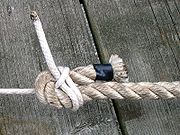
Sheet bend
Encyclopedia
The sheet bend is a bend, that is, a knot that joins two ropes together. Doubled, it is effective in binding lines of different diameter or rigidity securely together, although it has a tendency to work loose when not under load.
The sheet bend is related in structure to the bowline
. It is very fast to tie, and along with the bowline and clove hitch
is considered so essential it is knot №1 in the Ashley Book of Knots. It is a more secure replacement for the reef knot
(square knot), especially in its doubled variety.
 The sheet bend may be tied by various methods: the basic "rabbit through the hole" method of forming a half hitch
The sheet bend may be tied by various methods: the basic "rabbit through the hole" method of forming a half hitch
in the bight of the larger rope, by a more expedient method shown in Ashley as №1431 (similar to the method used by an experienced sailor or mountaineer to tie a bowline) or by a trick method, Ashley №2562, involving upsetting a noose knot over a short end of the "larger" rope. (Lines of equal size may be joined with a sheet bend, of course, but when one is larger, it plays the simpler role of the red line shown in the infobox, rather than forming the nipped hitch as the green line does.) For maximum strength it is desirable to have the free ends on the same side of the knot.
One type of weaver's knot is topologically
equivalent to a sheet bend, but is tied (usually in smaller stuff) with a different approach. Sheet bends are also used for netting.
 Notice that, in order to be most secure, the two free ends should end up on the same side of the knot (see below).
Notice that, in order to be most secure, the two free ends should end up on the same side of the knot (see below).
 When lines are of unequal diameter or rigidity it is necessary for security to "double" the sheet bend by making an additional round turn below the first and again bringing the working end back under itself. The free ends should end up on the same side of the knot for maximum strength.
When lines are of unequal diameter or rigidity it is necessary for security to "double" the sheet bend by making an additional round turn below the first and again bringing the working end back under itself. The free ends should end up on the same side of the knot for maximum strength.
The sheet bend is related in structure to the bowline
Bowline
The bowline is an ancient and simple knot used to form a fixed loop at the end of a rope. It has the virtues of being both easy to tie and untie. The bowline is sometimes referred as King of the knots because of its importance...
. It is very fast to tie, and along with the bowline and clove hitch
Clove hitch
A clove hitch is a type of knot. Along with the bowline and the sheet bend, it is often considered one of the most essential knots. A clove hitch is two successive half-hitches around an object. It is most effectively used as a crossing knot. It can be used as a binding knot, but is not...
is considered so essential it is knot №1 in the Ashley Book of Knots. It is a more secure replacement for the reef knot
Reef knot
The reef knot or square knot is an ancient and simple binding knot used to secure a rope or line around an object. Although the reef knot is often seen used for tying two ropes together, it is not recommended for this purpose due to potential instability of the knot.A reef knot is formed by tying...
(square knot), especially in its doubled variety.
Method

Half hitch
The half hitch is a simple overhand knot, where the working end of a line is brought over and under the standing part. Insecure on its own, it is a valuable component of a wide variety of useful and reliable hitches, bends, and knots....
in the bight of the larger rope, by a more expedient method shown in Ashley as №1431 (similar to the method used by an experienced sailor or mountaineer to tie a bowline) or by a trick method, Ashley №2562, involving upsetting a noose knot over a short end of the "larger" rope. (Lines of equal size may be joined with a sheet bend, of course, but when one is larger, it plays the simpler role of the red line shown in the infobox, rather than forming the nipped hitch as the green line does.) For maximum strength it is desirable to have the free ends on the same side of the knot.
One type of weaver's knot is topologically
Topology
Topology is a major area of mathematics concerned with properties that are preserved under continuous deformations of objects, such as deformations that involve stretching, but no tearing or gluing...
equivalent to a sheet bend, but is tied (usually in smaller stuff) with a different approach. Sheet bends are also used for netting.

Double sheet bend


